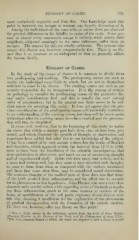Page 721 - My FlipBook
P. 721
ETIOLOGY OF CARIES. ^ 731
more exclusively vegetable and fruit diet. Our knowledge upon this
point is, however, too meagre to warrant any lengthy discussion of it.
Among the individuals of the same tribe or nation there are observed
the greatest differences in the liability to caries of the teeth. Some per-
sons in almost every community escape it entirely, while others, their
neighbors, subjected seemingly to the same influences, suffer from its
ravages. The reasons for this are wholly unknown. The persons who
escape this disease are, however, comparatively few. There is no dis-
ease that is so common or so widespread or that so generally afflicts
the human family.
Etiology of Caries.
In the study of the causes of disease it is common to divide them
into predisposing and exciting. The predisposing causes are such as
render the individual more liable to attack, but are not in themselves
suflicient to usher in the disease. The exciting causes are such as are
actually responsible for its inauguration. It is the custom of writers
on pathology to consider the predisposing causes of the particular dis-
ease under consideration first, and this is usually the most natural
order of presentation ; but in the present case there seems to be suf-
cient reason for reversing this order. It does not appear that the pre-
vious consideration of the predisposing causes will materially contribute
to an understanding of the exciting causes, but these will be much easier
understood after the exciting causes have been studied, and the presenta-
tion will thus be simplified.
It seems well, however, that in the beginning of this study we notice
the views that within a century past have from time to time been pre-
sented, and which illustrate the growth of thought as observation and
experience have added fact after fact to our knowledge of the subject.
It has been treated of by very ancient writers, but the works of Boudett
and Jourdain, which appeared within the interval from 1754 to 1766,
seem to have been the foundation of the scientific investigations that
were undertaken in after-years, and mark an era of awakening thought
and of experimental study. Before this time many had written, and in
a sense had written well, but they seem to have recorded such thoughts
as came to them from what, as compared with the authors mentioned
and those that came after them, may be considered casual observation.
The common thought of the medical men of those days was that decay
of the teeth resulted from inflammation, and the effort was to account
for its phenomena on tliat hypotliesis. John Hunter, who was a very close
observer and a careful writer, while regarding caries of the teeth as result-
ing from inflammation, much in the same manner as necrosis of the
bones or mortification of the soft parts, expresses dissatisfaction with
this idea, deeming it insufficient for the explanation of the phenomena
of gradual decomposition wdth the formation of the carious cavities.
He does not, however, offer any theory on this point.
^ This is fairly shown in the following extract from the work of John Hunter
(Practical Treatise on the D('.sra.s^.? of the Teeth, and the Consequences of them, 1778):
" The most common disease to which the teeth are exposed is such a decay as would


